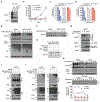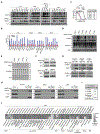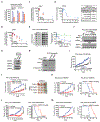Ubiquitination and degradation of SUMO1 by small-molecule degraders extends survival of mice with patient-derived tumors
- PMID: 34644148
- PMCID: PMC9450956
- DOI: 10.1126/scitranslmed.abh1486
Ubiquitination and degradation of SUMO1 by small-molecule degraders extends survival of mice with patient-derived tumors
Abstract
Discovery of small-molecule degraders that activate ubiquitin ligase–mediated ubiquitination and degradation of targeted oncoproteins in cancer cells has been an elusive therapeutic strategy. Here, we report a cancer cell–based drug screen of the NCI drug-like compounds library that enabled identification of small-molecule degraders of the small ubiquitin-related modifier 1 (SUMO1). Structure-activity relationship studies of analogs of the hit compound CPD1 led to identification of a lead compound HB007 with improved properties and anticancer potency in vitro and in vivo. A genome-scale CRISPR-Cas9 knockout screen identified the substrate receptor F-box protein 42 (FBXO42) of cullin 1 (CUL1) E3 ubiquitin ligase as required for HB007 activity. Using HB007 pull-down proteomics assays, we pinpointed HB007’s binding protein as the cytoplasmic activation/proliferation-associated protein 1 (CAPRIN1). Biolayer interferometry and compound competitive immunoblot assays confirmed the selectivity of HB007’s binding to CAPRIN1. When bound to CAPRIN1, HB007 induced the interaction of CAPRIN1 with FBXO42. FBXO42 then recruited SUMO1 to the CAPRIN1-CUL1-FBXO42 ubiquitin ligase complex, where SUMO1 was ubiquitinated in several of human cancer cells. HB007 selectively degraded SUMO1 in patient tumor–derived xenografts implanted into mice. Systemic administration of HB007 inhibited the progression of patient-derived brain, breast, colon, and lung cancers in mice and increased survival of the animals. This cancer cell–based screening approach enabled discovery of a small-molecule degrader of SUMO1 and may be useful for identifying other small-molecule degraders of oncoproteins.
Conflict of interest statement
Figures







Similar articles
-
SUMO1 degrader induces ER stress and ROS accumulation through deSUMOylation of TCF4 and inhibition of its transcription of StarD7 in colon cancer.Mol Carcinog. 2023 Sep;62(9):1249-1262. doi: 10.1002/mc.23560. Epub 2023 May 16. Mol Carcinog. 2023. PMID: 37191369 Free PMC article.
-
Determinants of small ubiquitin-like modifier 1 (SUMO1) protein specificity, E3 ligase, and SUMO-RanGAP1 binding activities of nucleoporin RanBP2.J Biol Chem. 2012 Feb 10;287(7):4740-51. doi: 10.1074/jbc.M111.321141. Epub 2011 Dec 22. J Biol Chem. 2012. PMID: 22194619 Free PMC article.
-
Evaluation of ubiquitination and sumoylation of acrosin inhibitor during in vitro capacitation of porcine sperm.Anim Biotechnol. 2021 Oct;32(5):646-655. doi: 10.1080/10495398.2021.1979568. Epub 2021 Sep 23. Anim Biotechnol. 2021. PMID: 34554078
-
Targeted protein degradation and the enzymology of degraders.Curr Opin Chem Biol. 2018 Jun;44:47-55. doi: 10.1016/j.cbpa.2018.05.004. Epub 2018 Jun 7. Curr Opin Chem Biol. 2018. PMID: 29885948 Review.
-
Small-Molecule Degraders beyond PROTACs-Challenges and Opportunities.SLAS Discov. 2021 Apr;26(4):524-533. doi: 10.1177/2472555221991104. Epub 2021 Feb 25. SLAS Discov. 2021. PMID: 33632029 Review.
Cited by
-
The emerging roles of SUMOylation in pulmonary diseases.Mol Med. 2023 Sep 5;29(1):119. doi: 10.1186/s10020-023-00719-1. Mol Med. 2023. PMID: 37670258 Free PMC article. Review.
-
The impact of dysregulation SUMOylation on prostate cancer.J Transl Med. 2025 Mar 6;23(1):286. doi: 10.1186/s12967-025-06271-2. J Transl Med. 2025. PMID: 40050932 Free PMC article. Review.
-
SUMO1 degrader extends mouse survival.Nat Rev Drug Discov. 2021 Dec;20(12):898. doi: 10.1038/d41573-021-00182-9. Nat Rev Drug Discov. 2021. PMID: 34728765 No abstract available.
-
Design and Characterization of a Novel eEF2K Degrader with Potent Therapeutic Efficacy Against Triple-Negative Breast Cancer.Adv Sci (Weinh). 2024 Feb;11(5):e2305035. doi: 10.1002/advs.202305035. Epub 2023 Dec 12. Adv Sci (Weinh). 2024. PMID: 38084501 Free PMC article.
-
Paradoxes of Cellular SUMOylation Regulation: A Role of Biomolecular Condensates?Pharmacol Rev. 2023 Sep;75(5):979-1006. doi: 10.1124/pharmrev.122.000784. Epub 2023 May 3. Pharmacol Rev. 2023. PMID: 37137717 Free PMC article. Review.
References
-
- Salami J, Crews CM, Waste disposal-An attractive strategy for cancer therapy. Science 355, 1163–1167 (2017). - PubMed
-
- Schapira M, Calabrese MF, Bullock AN, Crews CM, Targeted protein degradation: Expanding the toolbox. Nat. Rev. Drug Discov 18, 949–963 (2019). - PubMed
-
- Baek K, Schulman BA, Molecular glue concept solidifies. Nat. Chem. Biol 16, 2–3 (2020). - PubMed
-
- Kronke J, Udeshi ND, Narla A, Grauman P, Hurst SN, McConkey M, Svinkina T, Heckl D, Comer E, Li X, Ciarlo C, Hartman E, Munshi N, Schenone M, Schreiber SL, Carr SA, Ebert BL, Lenalidomide causes selective degradation of IKZF1 and IKZF3 in multiple myeloma cells. Science 343, 301–305 (2014). - PMC - PubMed
Publication types
MeSH terms
Substances
Grants and funding
LinkOut - more resources
Full Text Sources
Medical
Molecular Biology Databases
Research Materials
Miscellaneous

